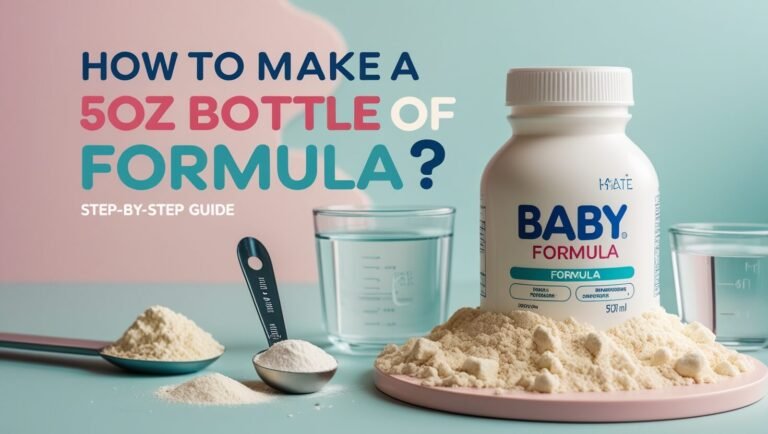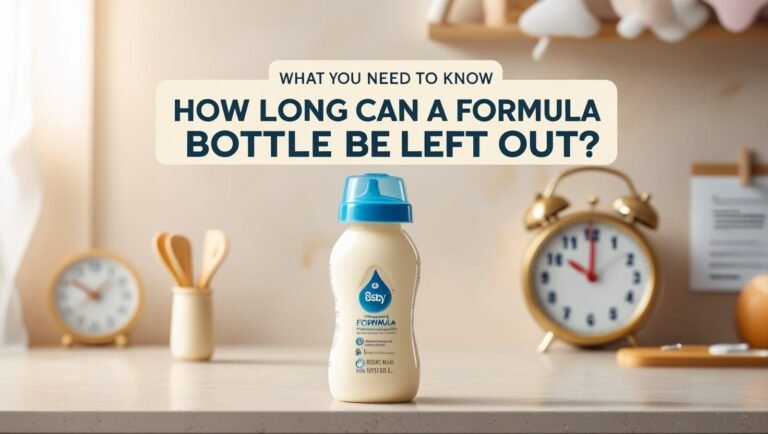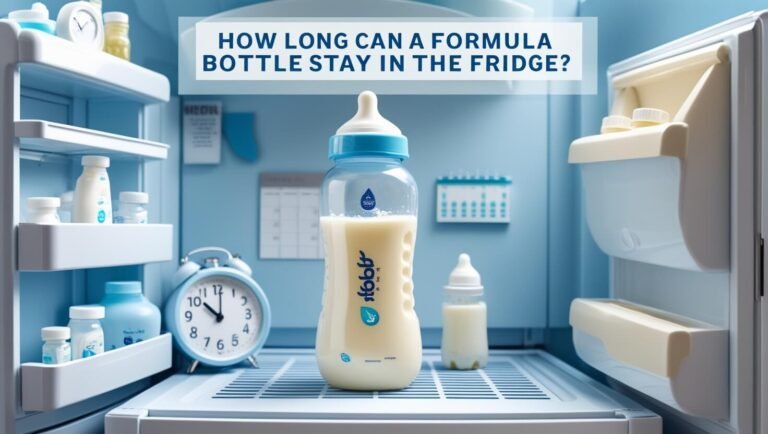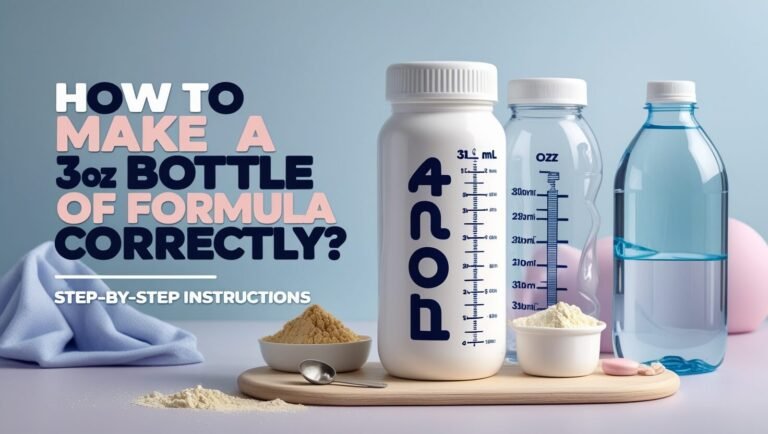How To Make A Formula Bottle: Essential Tips for Parents
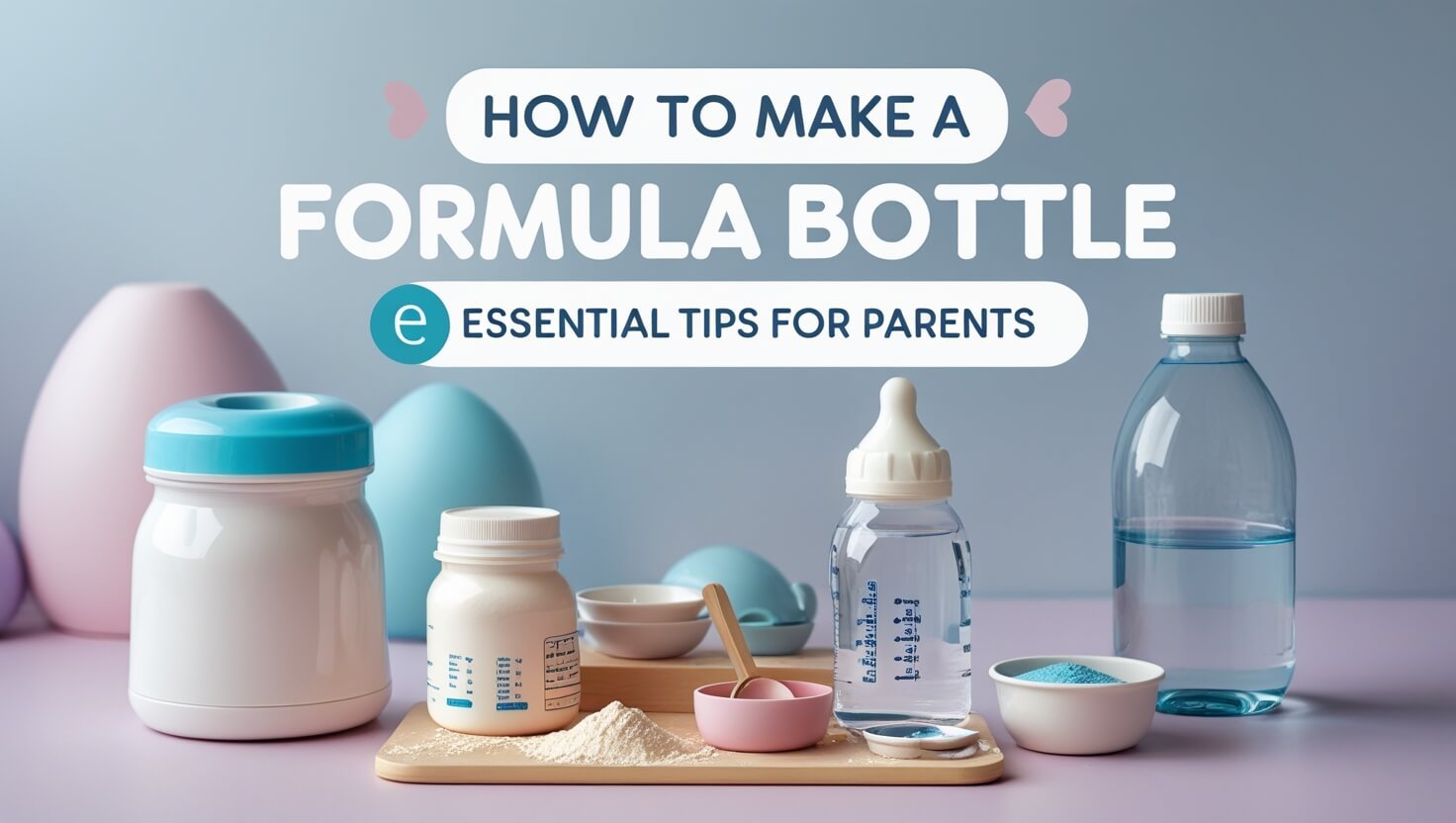
Are you wondering how to make a formula bottle for your little one? You want to ensure their health and safety. There are many options, like ready-to-feed, concentrated liquid, and powder. It can be hard to know where to start.
As a parent, you want the best for your baby. That includes a formula feeding guide that fits their needs. The Mayo Clinic says it’s key to prepare and store formula safely for your baby’s health.
Let’s explore how to prepare a formula bottle. We’ll talk about using clean water, sanitizing equipment, and following the manufacturer’s instructions. It’s important to use the right water type, depending on the formula you choose. Some formulas need low-fluoride water to avoid fluorosis.
Many parents, 71.9%, buy store-bought formula. And 61.2% prepare it from powders. So, a good formula feeding guide is essential. It helps ensure your baby gets the nutrients they need. In this article, we’ll give you a step-by-step guide on how to prepare a formula bottle. This will help you feel confident and prepared for this important part of your baby’s care.
Safety First: Clean Hands and Surface Preparation
When preparing baby bottle and infant formula, keeping things clean is key. The Centers for Disease Control and Prevention (CDC) say washing hands with soap and water before mixing formula is vital. This helps stop germs from spreading.
To keep things clean for infant formula mixing, sanitize your work area. Use a mild bleach solution or a sanitizing wipe on your counter and equipment. Also, have a list of what you need, like a clean bottle and nipple, to avoid contamination.
Proper Hand Washing Techniques
Washing your hands right is important. Rub them together for at least 20 seconds. This is critical when making baby bottle preparation and infant formula mixing for babies under 2 months, premature ones, or those with weak immune systems.
Sanitizing Your Work Area
Cleaning your work area is also key to avoid contamination. Make sure to clean and disinfect all surfaces, like the counter and sink. These steps help make a safe and clean space for infant formula mixing and baby bottle preparation.
Required Equipment Checklist
Having a checklist for equipment can prevent contamination. It should include:
- Clean bottle and nipple
- Formula container
- Measuring cups and spoons
- Sanitizing wipes or bleach solution
Create a safe and healthy space for mixing infant formula and preparing baby bottles.
Formula Safety Guidelines and Storage
When it comes to formula feeding guide, safety and storage are key. The CDC says to keep infant formula in a cool, dry spot. It should be away from sunlight and moisture. Always check the expiration date and use it before it expires.
A newborn feeding instructions guide suggests storing cooled boiled water in sterilized bottles. Seal them with a ring and disc in the fridge for up to 24 hours. If you prepare formula ahead, refrigerate it below 5°C within an hour. Use it within 24 hours if stored in the fridge.
- Store powdered formula in a cool, dry place.
- Use prepared formula within 24 hours if stored in the refrigerator.
- Discard formula after one hour at room temperature if refrigeration isn’t feasible.
Use a reliable formula feeding guide, check expiration dates, and follow manufacturer instructions to keep your baby safe.
Proper storage and handling of infant formula are critical to preventing bacterial contamination and ensuring the health of your baby.
Bottle Sterilization Methods
Ensuring the cleanliness of bottle feeding equipment is key. Sterilizing bottles and teats is a must. The Mayo Clinic suggests boiling them in water for 5 minutes. This method effectively kills germs and bacteria that could harm your baby.
Before boiling, clean the bottles and teats in hot, soapy water. This step removes any dirt or residue. Avoid using salt to clean teats, as it can be harmful to your baby. After cleaning, you can sterilize them.
Methods for Sterilization
There are several ways to sterilize bottles, including boiling, steam, and cold water methods. Boiling involves submerging them in boiling water for 5 minutes. Steam sterilization uses steam to kill germs, while cold water sterilization uses a solution. Always follow the manufacturer’s instructions for the method you choose.
Getting the formula milk ratio right is also important. Wrong ratios can affect the formula’s nutritional value, impacting your baby’s health. By following proper steps and sterilization methods, you ensure your baby’s safety and well-being.
Water Temperature Requirements
When preparing baby formula, the right water temperature is key. The CDC says to use water at room temperature or slightly warm. This helps prevent bacteria growth and keeps the formula safe.
For formula feeding tips, the ideal water temperature is between 70-75 degrees Fahrenheit. This ensures the formula is prepared correctly.
Using water that’s too hot or cold can harm the baby. About 30% of parents find it hard to get the water temperature right. It’s best to use water that’s no cooler than 70 degrees Fahrenheit. This helps the formula powder dissolve well.
Here are some important guidelines for baby formula preparation and formula feeding tips:
- Use room-temperature tap water, unless there are water safety concerns.
- Avoid hot water because of sediment and bacteria.
- Boil water and then cool it to 70 degrees Celsius for powdered formula.
By following these tips and using the correct water temperature, parents can make sure their baby’s formula is safe and nutritious. This makes formula feeding tips and baby formula preparation easier.
How to Make a Formula Bottle Step by Step
To prepare a formula bottle, it’s key to follow the infant formula mixing instructions from the manufacturer. The Mayo Clinic suggests this method to ensure the formula is made correctly and safely. Begin by accurately measuring water, as using too much or too little can impact the formula’s quality.
Measuring Water Accurately
Use fresh tap water for the formula, and make sure it’s at least 70°C after boiling. This step is vital to kill bacteria in the water.
Adding Formula Powder
Follow the water-to-powder ratio as instructed by the manufacturer. Different formula tins have different scoops, so use only the designated scoop. Adding extra formula powder can lead to constipation or dehydration in babies, so it’s important to get this right.
Mixing Techniques
Gently shake or stir the formula for proper infant formula mixing. Don’t add sugar or cereals to the formula bottle. Also, never microwave the formula, as it can burn the baby’s mouth. By following these steps and guidelines, you’ll prepare a safe and healthy formula bottle for your baby, mastering the art of how to make a formula bottle.
Testing Formula Temperature
Testing the formula temperature is a key step in newborn feeding instructions. The Centers for Disease Control and Prevention (CDC) says to check the formula temperature before feeding. This ensures it’s not too hot or too cold.
Formula that’s too hot can burn the baby, while too cold can be hard to digest. Getting the formula milk ratio right is also important. This includes testing the temperature.
To test the formula temperature, just put a few drops on your wrist. If it’s too hot, let it cool down before feeding. Always follow the manufacturer’s guidelines for preparing the formula. This helps avoid constipation or dehydration in infants.
Here are some tips for testing formula temperature:
- Use the wrist test: place a few drops of formula on the inside of your wrist to check the temperature.
- Wait for it to cool down: if the formula is too hot, wait for it to cool down before feeding the baby.
- Use a thermometer: if you’re unsure about the temperature, use a thermometer to check it.
Testing the formula temperature is vital for newborn feeding instructions. It ensures the baby’s safety and comfort. By following these tips and guidelines, you can make sure your baby gets the right formula at the right temperature. This also means you’re following the correct formula milk ratio.
| Formula Type | Temperature Guidelines |
|---|---|
| Powder Formula | Wait for 30 minutes after boiling water before adding the formula |
| Concentrated Liquid Formula | Use a thermometer to check the temperature |
| Ready-to-Feed Formula | Refrigerate and discard after 48 hours if not used |
Common Formula Mixing Mistakes
When preparing baby bottle preparation, getting it right is key for your baby’s health. A formula feeding guide helps, but knowing common mistakes is vital. One big error is mixing the wrong amount of water and formula, which can harm your baby.
The Mayo Clinic warns that the wrong mix can lead to poor nutrition or too much food. To avoid this, always follow the formula maker’s instructions. Use boiling water, then cool it to 70°C before adding the formula to lower bacterial risks.
Incorrect Water-to-Formula Ratio
Getting the water and formula mix wrong can cause dehydration, imbalance, seizures, and kidney problems. On the flip side, too diluted formula can lead to water poisoning, weight loss, and developmental delays. Stick to the 1 scoop for every 2 ounces of water ratio recommended by most US formula makers.
Temperature Issues
Using water that’s too hot or cold can also mess up the formula’s quality. Keep powdered and liquid formula at room temperature for no more than 2 hours after heating to keep it safe and good.
Storage Errors
Storing formula in a warm or humid place can spoil or contaminate it. To prevent this, keep prepared formula at 40°F (4°C) or lower in the fridge and use it within 24 hours.
| Mistake | Consequence |
|---|---|
| Incorrect water-to-formula ratio | Inadequate nutrition or overfeeding |
| Temperature issues | Affect the quality of the formula |
| Storage errors | Formula spoilage or contamination |
Knowing these common mistakes and how to avoid them ensures your baby gets the best nutrition. This is through proper baby bottle preparation and a reliable formula feeding guide.
Travel Tips for Formula Preparation
Traveling with a baby requires the right formula feeding tips for a safe and easy journey. The CDC says powdered formula is safe at room temperature for up to two hours. This makes it perfect for travel. Also, the TSA lets you bring baby formula or breast milk in a carry-on or checked bag. This is more flexible than other liquids and gels.
Here are some tips for baby formula preparation on the go:
- Pack extra formula in a checked bag for the whole trip, if you need special formula.
- Bring enough formula in your carry-on for the flight and any delays.
- Use clear bottles for easier screening.
Feeding your baby during takeoff and landing helps with air pressure changes. Keeping bottles at room temperature makes travel easier. You won’t need to heat bottles while traveling. By following these formula feeding tips, parents can have a smooth and fun trip with their baby.
Signs Your Baby is Ready to Feed
As a new parent, knowing when your baby is hungry is key. The Mayo Clinic says to look for signs like rooting or sucking on their hands. Following newborn feeding instructions and the right formula milk ratio makes feeding smoother.
Every baby is unique in their feeding needs. Yet, most show hunger signs like rooting, sucking noises, or turning towards food.
- Rooting or sucking on their hands
- Making sucking noises
- Turning their head towards the breast or bottle
Choosing the right feeding position is also important. Holding your baby upright or at an angle can make them more comfortable. This way, they can feed better. By following these newborn feeding instructions and using the correct formula milk ratio, your baby will thrive.
Hunger Cues
Every baby shows hunger in their own way. Look out for fussing, crying, or sucking sounds. Recognizing these cues and acting fast helps your baby feel secure and develop a good feeding habit.
Optimal Feeding Positions
Choosing the right feeding position is vital for your baby’s comfort. Holding them upright or at an angle helps them feed better and reduces spit-up. By following these tips and using the right formula milk ratio, your baby will feed comfortably and effectively.
Formula Storage Duration Guidelines
Storing formula safely is key when preparing baby bottles. The Centers for Disease Control and Prevention (CDC) says to keep infant formula in the fridge for up to 24 hours. After 24 hours, it’s best to throw it away to keep the baby safe.
For the best storage, keep formula in a clean, cool, dry spot. It’s important to use it within 4 weeks after opening. Don’t store it in humid or very hot places. Also, powdered baby formula should not be frozen.
Room Temperature Rules
A bottle of formula left at room temperature should be thrown away after two hours. Or, if the baby starts feeding, after one hour. This rule helps prevent bacteria like Cronobacter, which can harm infants.
Refrigeration Time Limits
Once made, formula can stay in the fridge for 24 hours. Always check the formula’s temperature before feeding. Use sterilized bottles, nipples, and utensils when making formula. These steps help keep the baby safe and healthy.
| Storage Method | Time Limit |
|---|---|
| Room Temperature | 2 hours or 1 hour after feeding starts |
| Refrigeration | 24 hours |
| Freezer | Not recommended for powdered formula |
By knowing and following these guidelines, parents can keep their baby’s formula safe and effective. This makes preparing baby bottles and feeding a healthy and joyful experience.
Proper Bottle Cleaning After Feeds
When it comes to formula feeding tips, cleaning bottles after each feed is key. This step stops bacteria from growing and keeps the baby formula preparation safe. The Mayo Clinic says to wash bottles and gear with soap and water after each use.
To clean bottles right, first rinse them with warm water. Then, wash them with soap and water. It’s also vital to sanitize often, more so for babies under 2 months, premature ones, or those with weak immune systems. You can sanitize by boiling, steaming, or using a bleach solution.
- Wash hands with soapy water before cleaning bottle-feeding equipment
- Use a dishwasher with hot water to kill more germs
- Air-dry infant feeding items on a clean towel to prevent germ growth
By sticking to these formula feeding tips and cleaning bottles well, you make sure your baby’s baby formula preparation is both safe and healthy.
In Closing
Preparing a formula bottle for your baby is a big responsibility. It needs careful attention to safety and cleanliness. Follow the instructions, use the right water, and store the formula correctly. This ensures your baby gets the nutrients they need to grow.
The right mix of formula and breast milk is key. Talk to your pediatrician to find the best ratio for your baby. They can help you adjust the mix based on your baby’s needs and feeding schedule. Introducing formula and breast milk together requires watching for any digestive problems.
As your baby grows, watch for hunger signs and feed them quickly. With the right steps and patience, you’ll create a feeding routine that supports your child’s growth. It will be nourishing and happy for them.
Common Questions:
How do I properly wash my hands before preparing a formula bottle?
Rub your hands together for at least 20 seconds to wash them properly. Use soap and water to clean your hands before making a formula bottle.
How do I sanitize the work area before preparing a formula bottle?
Clean the counter and any equipment with a sanitizing solution. This step is key to prevent contamination.
What is the recommended water temperature for mixing formula?
Use water that’s room temperature or slightly warm. This stops bacteria from growing and keeps the formula safe.
How do I properly measure the water and formula powder when making a formula bottle?
Accurate water measurement is vital. Too much or too little water can spoil the formula. Mix the formula carefully to ensure it’s right.
How do I test the temperature of the prepared formula before feeding my baby?
Test the formula by dropping a few drops on your wrist. It should be warm, not hot. Too cold can upset the baby’s stomach.
What are some common mistakes to avoid when mixing formula?
Avoid wrong water-to-formula ratios, temperature issues, and storage mistakes. These can harm the baby.
How do I prepare formula safely when traveling with my baby?
Wash your hands and sanitize the area when making formula on the go. Use clean equipment to keep things safe.
What are some signs that my baby is ready to be fed?
Look for signs like rooting or sucking on their hands. Feed your baby when they show these hunger cues.
How long can I store prepared formula?
Store formula in the fridge for up to 24 hours. Discard any unused formula after this time. Always follow the storage instructions and use it before the expiration date.
How do I properly clean bottles and equipment after feeding my baby?
Wash bottles and equipment with soap and water after each use. Sanitize them regularly to keep germs away.

